Chimeric antigen receptor targeting CD22 and application for chimeric antigen receptor
A chimeric antigen receptor and targeting technology, applied in the field of biomedicine, can solve problems affecting the assembly of TCR-CD3 complexes, affecting T cell activation signal transduction, and affecting T cell function, etc., achieving good application prospects and clinical applications Effective and improve the cure rate
- Summary
- Abstract
- Description
- Claims
- Application Information
AI Technical Summary
Problems solved by technology
Method used
Image
Examples
Embodiment 1
[0048] gene sequence synthesis
[0049] The traditional CD22 chimeric antigen receptor molecule (CAR1) with 4-1BB as costimulatory domain and CD3ζ chain as intracellular signaling domain was synthesized by whole gene synthesis. Transmembrane protein signal peptide, CD22 antibody single chain variable region, hinge region of CD8 protein molecule, transmembrane region, 4-1BB co-stimulatory domain and CD3ζ intracellular signal transduction domain are serially connected in sequence. The signal peptide sequence is selected from human CD8 molecules, and the CD8 signal peptide gene sequence is shown in SEQ ID NO.19. The CD22 antibody single-chain variable region gene sequence is selected from SEQ ID NO.23 and SEQ ID NO.24.
Embodiment 2
[0051] gene sequence synthesis
[0052] The traditional CD22 chimeric antigen receptor molecule (CAR2) with 4-1BB as costimulatory domain and CD3ζ chain as intracellular signaling domain was synthesized by whole gene synthesis. Transmembrane protein signal peptide, CD22 antibody single chain variable region, hinge region of CD8 protein molecule, transmembrane region, 4-1BB co-stimulatory domain and CD3ζ intracellular signal transduction domain are serially connected in sequence. The signal peptide sequence is selected from human GM-CSFR molecules, and the GM-CSFR signal peptide gene sequence is shown in SEQ ID NO.20. The CD22 antibody single-chain variable region gene sequence is selected from SEQ ID NO.25 and SEQ ID NO.26.
Embodiment 3
[0054] gene sequence synthesis
[0055] The CD22 chimeric antigen receptor sequence was synthesized by whole gene synthesis, including signal peptide, antigen recognition region, and TCR constant region domain (CAR3), wherein the CD8 signal peptide gene sequence is shown in SEQ ID NO.19. The CD22 antibody single-chain variable region gene sequence is selected from SEQ ID NO.21 and SEQ ID NO.22. The heavy chain CH1 gene sequence is shown in SEQ ID NO.27, the light chain constant region gene sequence CL is shown in SEQ ID NO.28; the gene sequences of TCRα, TCRβ, TCRγ, and TCRδ constant regions are respectively shown in SEQ ID Shown in NO.29, SEQ ID NO.30, SEQ ID NO.31, SEQ ID NO.32. The two polypeptide chains are connected by T2A, as shown in SEQ ID NO.33. After the sequence is synthesized, it is cloned into a preferred lentiviral vector using restriction sites NheI and SalI. The lentiviral vector is PCDH-EF1α-MCS-PURO or any other lentiviral overexpression vector.
PUM
| Property | Measurement | Unit |
|---|---|---|
| molecular weight | aaaaa | aaaaa |
Abstract
Description
Claims
Application Information
 Login to View More
Login to View More - R&D
- Intellectual Property
- Life Sciences
- Materials
- Tech Scout
- Unparalleled Data Quality
- Higher Quality Content
- 60% Fewer Hallucinations
Browse by: Latest US Patents, China's latest patents, Technical Efficacy Thesaurus, Application Domain, Technology Topic, Popular Technical Reports.
© 2025 PatSnap. All rights reserved.Legal|Privacy policy|Modern Slavery Act Transparency Statement|Sitemap|About US| Contact US: help@patsnap.com



